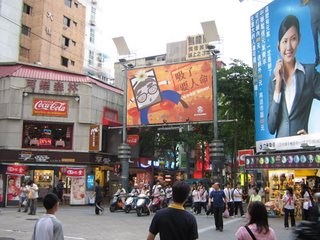 Shi Men Ding
Shi Men Ding Shibuya. V-Dub, representing Deutschland!
Shibuya. V-Dub, representing Deutschland!
 Shi Men Ding
Shi Men Ding Shibuya. V-Dub, representing Deutschland!
Shibuya. V-Dub, representing Deutschland!
 We rode the train back from Taitung to Taipei, bringing us past miles and miles of green, vast expanses of rushing waters. It felt like a page out of Goodbye South, Goodbye, only through the windows of a train and not on a motorcycle. We were going north. They in the movie were going all over Taiwan.
We rode the train back from Taitung to Taipei, bringing us past miles and miles of green, vast expanses of rushing waters. It felt like a page out of Goodbye South, Goodbye, only through the windows of a train and not on a motorcycle. We were going north. They in the movie were going all over Taiwan. Beverages are big. This is not the first or last time I rant about beverages in Taiwan. This bottle from the local 7-11 (or just "seven", in colloquial Taiwan-speak) is chocolate milk tea. What it actually tasted like was sugar plus water plus cheap non-fat dried milk and a hint of tea. I don't care. I still like beverages.
Beverages are big. This is not the first or last time I rant about beverages in Taiwan. This bottle from the local 7-11 (or just "seven", in colloquial Taiwan-speak) is chocolate milk tea. What it actually tasted like was sugar plus water plus cheap non-fat dried milk and a hint of tea. I don't care. I still like beverages. Even when the food stands have gone to bed for the night, you can still find all sorts of hot and cold food 24 hours a day at 7-11. This riceball has a very complicated system of packaging that keeps the dried seaweed wrapped around the rice separate until right when you remove the plastic for consumption. Don't ask me how it works. I just pull the arrows in the order they're numbered, and a fresh riceball with crispy seaweed appears.
Even when the food stands have gone to bed for the night, you can still find all sorts of hot and cold food 24 hours a day at 7-11. This riceball has a very complicated system of packaging that keeps the dried seaweed wrapped around the rice separate until right when you remove the plastic for consumption. Don't ask me how it works. I just pull the arrows in the order they're numbered, and a fresh riceball with crispy seaweed appears. This is what I am referring to when I say pudding. It is most similar to Spanish flan, but more gelatinous and less creamy. When we were little, this was our snack of choice. There are a variety of ways to eat it. Perfectionists choose to dump it out inverted on a plate, like the serving suggestion pictured on the packaging. Some people eat it without mixing the dark caramel part with the eggy part. Me, I blend it all up into the smallest pieces I can possibly manage.
This is what I am referring to when I say pudding. It is most similar to Spanish flan, but more gelatinous and less creamy. When we were little, this was our snack of choice. There are a variety of ways to eat it. Perfectionists choose to dump it out inverted on a plate, like the serving suggestion pictured on the packaging. Some people eat it without mixing the dark caramel part with the eggy part. Me, I blend it all up into the smallest pieces I can possibly manage. How do you eat yours?
How do you eat yours?

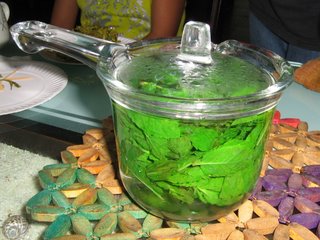 On the side of the house there are some mint plants, which, as evident here, can be plucked and placed in hot water to make fresh mint tea.
On the side of the house there are some mint plants, which, as evident here, can be plucked and placed in hot water to make fresh mint tea.
 The color is very light and the flavor is very subtle and refreshing.
The color is very light and the flavor is very subtle and refreshing.

 There's no direct translation for bao ze into English, but you can see what they are. Fluffy dough wrapped around stuff. The stuff in the middle can be meat, or a mixture of meat and vegetables, or bean paste.
There's no direct translation for bao ze into English, but you can see what they are. Fluffy dough wrapped around stuff. The stuff in the middle can be meat, or a mixture of meat and vegetables, or bean paste.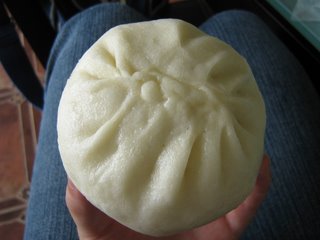 Every store has a system of labelling their boa ze so you know what's inside. Unlike a box of chocolates, where you never know what you're going to get, the labelling makes it easy for vegetarians to avoid the meat boa ze.
Every store has a system of labelling their boa ze so you know what's inside. Unlike a box of chocolates, where you never know what you're going to get, the labelling makes it easy for vegetarians to avoid the meat boa ze. While the meat bao ze didn't have any markings, the swan tsai (pickled leafy vegetables) bao has a pink dot on top.
While the meat bao ze didn't have any markings, the swan tsai (pickled leafy vegetables) bao has a pink dot on top.
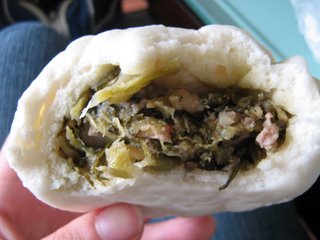
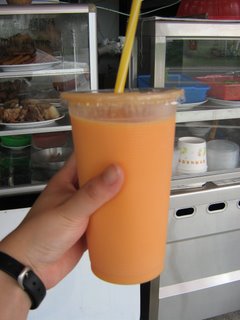 The lady who makes the juices.
The lady who makes the juices.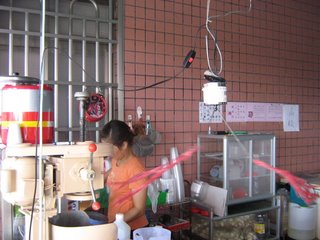 On the left, papaya. On the right, pineapple.
On the left, papaya. On the right, pineapple.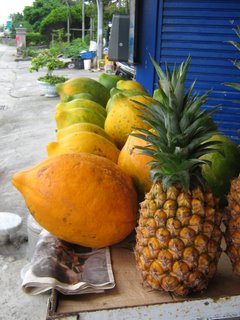 Because in Taiwan, pig skin and intestines are sold alongside wonderful fruit juices.
Because in Taiwan, pig skin and intestines are sold alongside wonderful fruit juices.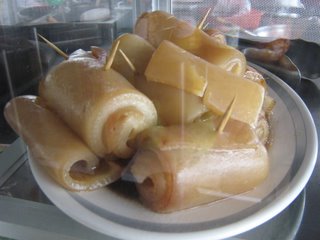
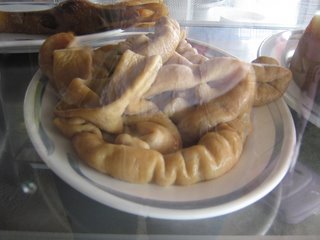
 FISH EYE SOUP FOR BREAKFAST!!! Clockwise from the fish eye soup: fried eggs with daikon, spicy eggplant, greenbeans. All the dining tables at our B&B had inlays of sand and shells, quite delightful.
FISH EYE SOUP FOR BREAKFAST!!! Clockwise from the fish eye soup: fried eggs with daikon, spicy eggplant, greenbeans. All the dining tables at our B&B had inlays of sand and shells, quite delightful.
 I'm not a fan of Cabernets. If you want to appear like you know wines, definitely go with the pinots. Little known fact: Champagne is often made from the same grapes used to make pinot noir, a red wine. The type of grape determines not the color of the wine, as wine color is determined by how long the skin is in contact with the juice. I don't know if anybody makes wine with green grapes, but green grapes does not equal white wine. Chardonnay grapes are green, pinot grapes are really dark purple, but !gasp! sometimes a champagne can have both!
I'm not a fan of Cabernets. If you want to appear like you know wines, definitely go with the pinots. Little known fact: Champagne is often made from the same grapes used to make pinot noir, a red wine. The type of grape determines not the color of the wine, as wine color is determined by how long the skin is in contact with the juice. I don't know if anybody makes wine with green grapes, but green grapes does not equal white wine. Chardonnay grapes are green, pinot grapes are really dark purple, but !gasp! sometimes a champagne can have both! For dessert, we had a mille-crepe from a place called Deep Blue in Tainan. There's only one dessertery that makes it just right. A mille-crepe is just that - a thousand crepes piled on top of each other, with a thin layer of cream in between each layer. In actuality, I think they only have room to put about 30 layers before it just gets out of hand.
For dessert, we had a mille-crepe from a place called Deep Blue in Tainan. There's only one dessertery that makes it just right. A mille-crepe is just that - a thousand crepes piled on top of each other, with a thin layer of cream in between each layer. In actuality, I think they only have room to put about 30 layers before it just gets out of hand. I really liked the business card that came with our refrigerated-mail-delivered cake. It looks like the size of a normal business card but flips out to reveal the contact information for the store.
I really liked the business card that came with our refrigerated-mail-delivered cake. It looks like the size of a normal business card but flips out to reveal the contact information for the store. What you can't tell is that the other half of the mille-crepe is smashed from the rough handling during transport.
What you can't tell is that the other half of the mille-crepe is smashed from the rough handling during transport. I am a master at taking pictures of tasty things. Or at least, I felt like that after taking this photo, completely avoiding the smashed side while making the cake look presentable.
I am a master at taking pictures of tasty things. Or at least, I felt like that after taking this photo, completely avoiding the smashed side while making the cake look presentable.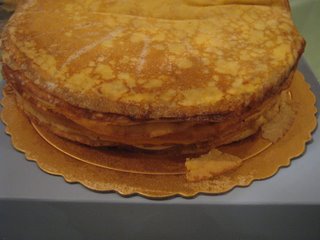
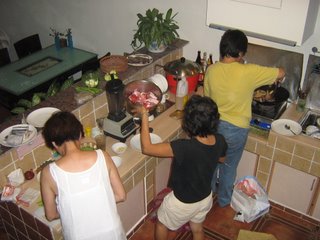 From left, Faye with the beans, the owner of the B&B with the fish, and my aunt cooking stuff.
From left, Faye with the beans, the owner of the B&B with the fish, and my aunt cooking stuff.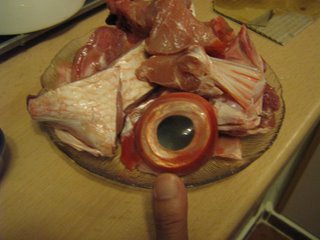 Check out the EYE! It's 3x the size of my thumb! This pile of fish was used to make the soup, and the owner of the B&B had the portion with the eye.
Check out the EYE! It's 3x the size of my thumb! This pile of fish was used to make the soup, and the owner of the B&B had the portion with the eye. The table setting at our B&B. For a few days, we were like family to the owner lady.
The table setting at our B&B. For a few days, we were like family to the owner lady. The infamous fish soup, with bits of the eye visible in the lower right corner.
The infamous fish soup, with bits of the eye visible in the lower right corner.
 Green beans...a bit too tough and not salty enough.
Green beans...a bit too tough and not salty enough.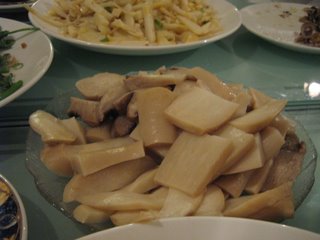


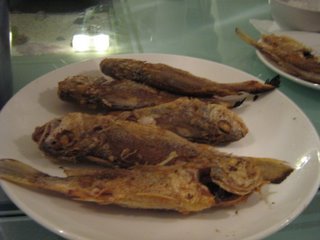 An entire fried fish. In theory, a very tasty idea. In my mother's hands, amazing. In other people's hands...slightly non-crispy and not salty enough.
An entire fried fish. In theory, a very tasty idea. In my mother's hands, amazing. In other people's hands...slightly non-crispy and not salty enough.
 Remember when we went to the market to get food for dinner? Yeah. This is only a teaser for the huge meal yet to come. In the meantime, more local fruit from Taitung.
Remember when we went to the market to get food for dinner? Yeah. This is only a teaser for the huge meal yet to come. In the meantime, more local fruit from Taitung.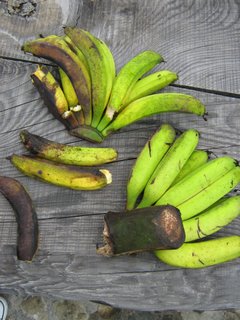 A random neighbor came by on his scooter and dropped off some bananas from his yard. In Taitung, you hardly ever need to buy food, because it's understood that if you have more than you can eat, you pass it on to your neighbors. If everybody grows different things, what you get is a "free" cornucopia of fresh produce.
A random neighbor came by on his scooter and dropped off some bananas from his yard. In Taitung, you hardly ever need to buy food, because it's understood that if you have more than you can eat, you pass it on to your neighbors. If everybody grows different things, what you get is a "free" cornucopia of fresh produce.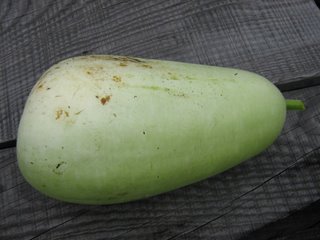 This, also from a neighbor. Tung Gua's English is either wax gourd or winter melon.
This, also from a neighbor. Tung Gua's English is either wax gourd or winter melon. Betel nuts, in their natural form. More to come on the subculture of betel nuts in a separate entry. from the way they are arranged on the tree, I am led to believe that betel is related to coconuts, but smaller.
Betel nuts, in their natural form. More to come on the subculture of betel nuts in a separate entry. from the way they are arranged on the tree, I am led to believe that betel is related to coconuts, but smaller.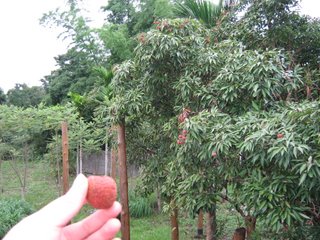 Lychee, and the tree that bore it. Found in the side yard of a consultant for running B&Bs.
Lychee, and the tree that bore it. Found in the side yard of a consultant for running B&Bs.